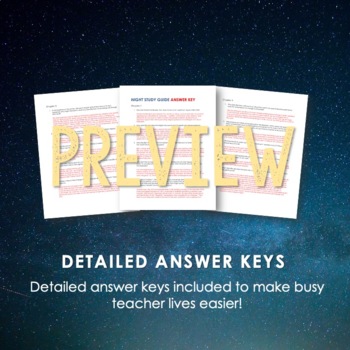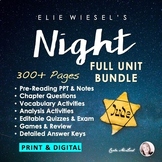Night Study Guide - Elie Wiesel - Chapter-by-Chapter Questions
- Zip
- Google Apps™

What educators are saying
Also included in
- Elie Wiesel’s memoir, Night, has become a standard text for many high school and middle school classes to teach about both the history and human impact of the Holocaust. This 300+ page Night unit mega-bundle includes everything you need to make this critical story meaningful and memorable for your sPrice $19.50Original Price $32.50Save $13.00
- This Q4 ELA Curriculum for 9th and 10th grade English has ALL the materials you need—lessons, materials, text choices, and pacing guide—to teach a full 9-week quarter of high school English, with a focus on novel study, ELA test prep, and end of year activities. The novel / memoir units provided inPrice $59.00Original Price $99.40Save $40.40
- This Full Year ELA Curriculum Bundle for 9th and 10th grade English has ALL the resources you need—lessons, materials, text choices, answer keys, and pacing guides—to teach a full 180 days of high school English. Whether you are a new ELA teacher, or teaching a new ELA class or grade level, or a vetPrice $189.90Original Price $382.08Save $192.18
Description
This resource provides chapter-by-chapter questions for Elie Wiesel’s haunting memoir, Night, that will help connect your students to the story, ensure they comprehend key plot developments, and are able to analyze events, characters and themes at a deeper level. Questions range in complexity level--from comprehension to analysis and evaluation—so that students can practice a variety of standards and skills while getting the most out of this critical work.
If you are teaching classes online, this study guide can work well as an independent learning packet. It is provided not only as an attractively designed PDF, but also as a Word document, so that it can be as flexible as possible for your instructional needs.
Some ideas on how to use the study guide for your online classroom include:
•USE AS A PDF: Simply post this PDF on your Learning Management System (LMS), and have your students complete the questions, then return their work to you digitally for grading. For simple and effective tips on how to do this, click here.
•WORD DOCUMENT FLEXIBILITY: Because the resource is also included as a Word document, it allows even more flexibility. For example, you can cut and paste questions and sections directly into your LMS learning modules for use in class assignments, discussion boards, quizzes, ESOL/ESE support, enrichment activities and more. It enables you to design your course according to your students’ individual needs.
Note: this resource is based on the 2006 Marion Wiesel translation of Night.
You may also like:
•Night Pre-Reading Informal Debate Activity
•Night Introductory PPT, Guided Notes, FAQs & Quiz
•”The Perils of Indifference,” Wiesel, Rhetorical Analysis
•Short Story Ultimate Mega-Bundle: 8 Stories, 13 Resources
Keywords: Night, Elie Wiesel, Night 2006 Version Study Guide, Night Chapter Questions, Night Analysis Question, Night Literature Guide, Night Marion Wiesel version








